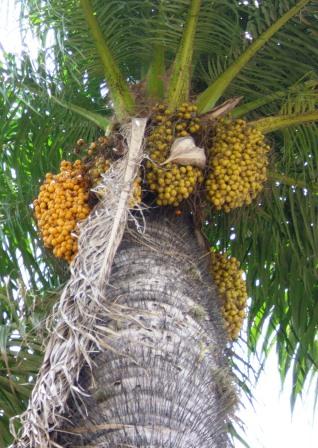Agronomic Performance of Three Sunflower Varieties (Helianthus annuus L.) in Topes de Collantes Mountain Community, Cuba
Main Article Content
Resumen
Considering the permanent human need to meet the food demands, current efforts are being made to diversify crop productions and foster multipurpose crops. Accordingly, a study was made in Topes de Collantes mountain community, where there is a predominance of farms under agroecological conversion. The aim of this research was to evaluate the morphological and productive indicators of three sunflower varieties for introduction in local agro-forest-grazing systems. The varieties studied were Cubasol 113, Caburé 15, and CIAP JE 94. The treatments for seed germination were dipped in water for 6, 12, and 24 h. The various phenological phases of the crop were determined in the field. Additionally, growth indicators like height, stem thickness, and number of leaves were evaluated; as well as productive indicators capitulum diameter, number of seeds per capitulum, and total seed weight, from which the yields of the three varieties were estimated. Multifactorial and one-way ANOVA analyses were performed for statistical processing. The best treatment was the 12 h dipping, and the best variety was Cubasol 113, with over 70% germination. The height, stem thickness, and leaf number values for the three varieties matched the responses described for them under other edaphoclimatic conditions. The productive values of variety CIAP JE 94 were higher than the values for Cubasol 113 and Caburé 15 under the conditions of the study.
Descargas
Resumen
Considering the permanent human need to meet the food demands, current efforts are being made to diversify crop productions and foster multipurpose crops. Accordingly, a study was made in Topes de Collantes mountain community, where there is a predominance of farms under agroecological conversion. The aim of this research was to evaluate the morphological and productive indicators of three sunflower varieties for introduction in local agro-forest-grazing systems. The varieties studied were Cubasol 113, Caburé 15, and CIAP JE 94. The treatments for seed germination were dipped in water for 6, 12, and 24 h. The various phenological phases of the crop were determined in the field. Additionally, growth indicators like height, stem thickness, and number of leaves were evaluated; as well as productive indicators capitulum diameter, number of seeds per capitulum, and total seed weight, from which the yields of the three varieties were estimated. Multifactorial and one-way ANOVA analyses were performed for statistical processing. The best treatment was the 12 h dipping, and the best variety was Cubasol 113, with over 70% germination. The height, stem thickness, and leaf number values for the three varieties matched the responses described for them under other edaphoclimatic conditions. The productive values of variety CIAP JE 94 were higher than the values for Cubasol 113 and Caburé 15 under the conditions of the study.
Article Details

Esta obra está bajo licencia internacional Creative Commons Reconocimiento-NoComercial-SinObrasDerivadas 4.0.
Derechos de autor 2018
Copyright ©Agrisost/ (CC BY-NC-SA 4.0)

Esta obra está bajo licencia internacional
Creative Commons Reconocimiento-NoComercial-SinObrasDerivadas 4.0
Citas
Alemán, R. (2003a). El cultivo del girasol (Helianthus annuus L.) en el marco de una agricultura sostenible. Centro agrícola, 30 (1), 90-91. Retrieved from: http://cagricola.uclv.edu.cu/descargas/pdf/V30-Numero_1/cag201031280.pdf
Alemán, R. (2003b). Influencia de las fechas de siembra sobre el porcentaje de aceite y rendimiento en aquenios en el cultivo del girasol (Helianthus annuus L.) en suelos pardos con carbonatos. Centro Agrícola, 30 (2), 61-64. Retrieved from: http://cagricola.uclv.edu.cu/descargas/pdf/V30-Numero_2/cag132031294.pdf
Alemán, R., Hernández, C., Blanco, S. & Silverio, P. (1995). Estudio de líneas de girasol promisorias para granos. Centro Agrícola, 22(2): 95-96.
Cerreta, S. (2005). Evaluación de cultivares de girasol evaluados en la zafra 2004-2005. Programa nacional de evaluación de cultivares. Retrieved from: http://www.iniaorg.uy/convenio-inace-inia/resultadosgir/gir.htm
Ilmi, A. (2016). Respuesta morfofisiológica y agronómica (Helianthus annuus L. cv. CIAP JE- 94) ante la fitoestimulación con FitoMas – E. (Tesis en opción al título de Ingeniero Agrónomo). Facultad de Ciencias Agropecuarias. Universidad Central “Marta Abreu” de las Villas. Cuba. Retrieved from: http://dspace.uclv.edu.cu/bitstream/handle/123456789/6365/A%C3%AFcha%20Ilmi%20Osman_2016.pdf?sequence=1&isAllowed=y
Leiva, L., García, J. & Delgado, M. (2018). Efecto de diferentes densidades de siembra sobre el rendimiento del cultivo del girasol (Helianthus annuus L.) var, Caburé-15 en suelos arroceros. Revista Infociencia, 22(1). Retrieved from: http://www.magon.cu/Doc/Vol22No%201/1074EFECTODEDIFERENTESDENSIDADESDESIEMBRA.pdf
Pacheco, J. & Alemán, R. (2003). Uso del agua por el girasol (Helianthus annuus L.) en suelo pardo con carbonatos y siembras de diciembre sin regadío. Centro Agrícola, 30(2), 5-8. Retrieved from: http://cagricola.uclv.edu.cu/descargas/pdf/V30-Numero_2/cag022031283.pdf
Pacheco, R. & Vázquez, H. (2001). Criterios generales acerca del cultivo del girasol: preparación del suelo, uso de herbicidas y fertilización. Electrónica Granma Ciencia, 5 (1):20-25
Padilla, C. (2006). Evaluación de híbridos y una variedad naturalizada de girasol para la producción de granos. Revista cubana de Ciencia Agrícola, 40(1), 105-109. Retrieved from: http://www.redalyc.org/pdf/1930/193017708015.pdf
Penichet, C., Guerra, G. & Carballo, P. (2008). El girasol. Sus posibilidades económico – productivas en el desarrollo agropecuario. Observatorio de la Economía Latinoamericana, (95), 1-13. Retrieved from: http://www.eumed.net/cursecon/ecolat/cu/2008/cgg.pdf
Penichet, C., Alemán, R. & Caraballo, P. (2010). El cultivo del girasol como alternativa forrajera viable para la alimentación del ganado. Centro Agrícola, 37(2), 69-73. Retrieved from: http://cagricola.uclv.edu.cu/descargas/pdf/V37-Numero_2/Art%2011.pdf
Reyes, A. (2006). Indicadores de calidad de suelo en áreas cafetaleras de Topes de Collantes. (Tesis en opción al grado de Doctor en Ciencias Agrícolas). Departamento de Agronomía. Universidad Central “Marta Abreu” de Las Villas, Cuba.
Sánchez, M., Oramas, G., Fernández, J., Marrero, V. & Ayala, A. (2004). El girasol, una alternativa sostenible en la seguridad alimentaria de la familia rural. Revista ACPA, 3-4, 51-53. Retrieved from: http://www.actaf.co.cu/revistas/Revista%20ACPA/2004/REVISTA%2003%20Y%2004/20%20EL%20GIRASOL.pdf
Soares, D. B. (2014). Efecto del FitoMas - E sobre el crecimiento y rendimiento del girasol (Helianthus annuus L. cv. CIAP JE- 94). (Tesis en opción al título de Ingeniero Agrónomo). Facultad de Ciencias Agropecuarias. Universidad Central “Marta Abreu” de las Villas, Cuba. Retrieved from: http://dspace.uclv.edu.cu/bitstream/handle/123456789/690/A0051.pdf?sequence=1&isAllowed=y

